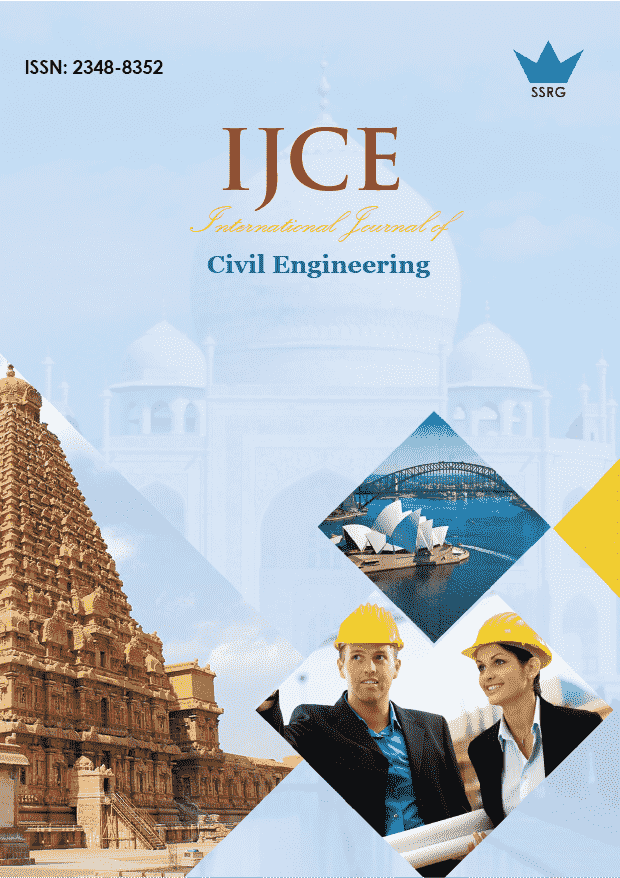Laboratory Study of Vibration Isolation Performance of Needle Felt Coir Latex Composite (NFCLC) Trench Type Wave Barriers

| International Journal of Civil Engineering |
| © 2023 by SSRG - IJCE Journal |
| Volume 10 Issue 7 |
| Year of Publication : 2023 |
| Authors : M. Lekshmi Chandran, V. Jaya, K. Balan |
How to Cite?
M. Lekshmi Chandran, V. Jaya, K. Balan, "Laboratory Study of Vibration Isolation Performance of Needle Felt Coir Latex Composite (NFCLC) Trench Type Wave Barriers," SSRG International Journal of Civil Engineering, vol. 10, no. 7, pp. 45-57, 2023. Crossref, https://doi.org/10.14445/23488352/IJCE-V10I7P103
Abstract:
Ground vibrations can be caused by various sources such as traffic, construction activities, and industrial machinery. These vibrations can propagate through the ground and into adjacent structures or the environment. Predicting and controlling ground vibrations are essential in various fields, such as transportation, construction, and industrial activities. Regulations and guidelines have been developed in many countries to manage the impact of ground vibrations on people and structures. Open and In-filled trenches are practiced as barriers for mitigating ground vibrations in engineering practices. Coir latex wave barriers are highly sustainable barrier that combines the natural strength of coir fibers with the durability and weather-resistant properties of natural latex. The vibration isolation performance of in-filled trenches using Coir Latex composite was evaluated through laboratory model studies. The study assessed the impact of various factors, such as the trench geometry, latex content, and composite material properties, on the in-filled trenches' isolation performance. The composite with an equal latex and coir fiber content ratio demonstrated over 75% wave isolation efficiency, indicating its effectiveness as a vibration isolation solution.
Keywords:
Ground vibrations, Coir-Latex composite, Wave barriers, Wave isolation efficiency, Amplitude reduction ratio.
References:
[1] Tulika Bose et al., “Efficiency of Open and Infill Trenches in Mitigating Ground-Borne Vibrations,” Journal of Geotechnical and Geoenvironmental Engineering, vol. 144, no. 8, 2018.
[CrossRef] [Google Scholar] [Publisher Link]
[2] J. S. Dhanya, A. Boominthan, and P. J. Silpa, “Use of Sand-Rubber Mixture (SRM)-Filled Trenches for Pile Driving Induced Vibration Screening,” IACMAG 2021: Challenges and Innovations in Geomechanics, pp. 205-212, 2021.
[CrossRef] [Google Scholar] [Publisher Link]
[3] Majid Jazebi et al., “Performance of Open and In-Filled (Geofoam) Trenches in Mitigating Ground-Borne Vibrations Induced by Impact Loading,” International Journal of Pavement Research and Technology, vol. 16, pp. 718-730, 2023.
[CrossRef] [Google Scholar] [Publisher Link]
[4] C. Sumesh, P.K. Jayasree, and K.Balan, “Development of a Coir Fiber-Latex Composite Sheet for Use as a Separators in Flexible Pavements,” Indian Geotechnical Conference, 2015.
[Google Scholar] [Publisher Link]
[5] V. Jaya, M. Lekshmi Chandran, and N. Lakshmi Nandan, “Evaluation of Ground Vibration Isolation using In-Filled CIR-Latex Composite Trenches,” Indian [CrossRef] [Publisher Link]
[6] R. D. Woods, “Screening of Surface Waves in Soils,” Journal of Soil Mechanics and Foundations Division, ASCE, vol. 94, no. 4, pp. 951-979, 1968.
[Publisher Link]
[7] Ashref Alzawi, and M. Hesham El Naggar, “Full Scale Experimental Study on Vibration Scattering using Open and In-Filled (Geofoam) Wave Barriers,” Soil Dynamics and Earthquake Engineering, vol. 31, no. 3, pp. 306-317, 2011.
[CrossRef] [Google Scholar] [Publisher Link]
[8] M. Naghizadehrokni, M. Ziegler, and J. Sprengel, “A Full Experimental and Numerical Modelling of the Practicability of Thin Foam Barrier as Vibration Reduction Measure,” Soil Dynamics and Earthquake Engineering, vol. 139, p. 106416, 2020.
[CrossRef] [Google Scholar] [Publisher Link]
[9] Erkan Çelebi et al., “Field Experiments on Wave Propagation and Vibration Isolation by Using Wave Barriers,” Soil Dynamics and Earthquake Engineering, vol. 29, no. 5, pp. 824–833, 2009.
[CrossRef] [Google Scholar] [Publisher Link]
[10] Al-Hussaini, and Tahmeed Malik, Vibration Isolation by Wave Barriers, Buffalo: State University of New York, 1992.
[Publisher Link]
[11] S.E. Kattis, D. Polyzos, and D.E. Beskos, “Modeling of Pile Wave Barriers by Effective Trenches and their Screening Effectiveness,” Soil Dynamics and Earthquake Engineering, vol. 18, no. 1, pp. 1–10, 1999.
[CrossRef] [Google Scholar] [Publisher Link]
[12] J.G. Wang, W. Sun, and S. Anand, “Numerical Investigation on Active Isolation of Ground Shock by Soft Porous Layers,” Journal of Sound and Vibration, vol. 321, no. 3-5, pp. 492-509, 2009.
[CrossRef] [Google Scholar] [Publisher Link]
[13] Ankurjyoti Saikia, and Utpal Kumar Das, “Analysis and Design of Open Trench Barriers in Screening Steady-State Surface Vibrations,” Earthquake Engineering and Engineering Vibration, vol. 13, no. 3, pp. 545-554, 2014.
[CrossRef] [Google Scholar] [Publisher Link]
[14] W. Haupt, “Isolation of Vibrations by Concrete Core Walls,” Proceedings of the Ninth International Conference on Soil Mechanics and Foundation Engineering, pp. 251–256, 1977.
[Google Scholar]
[15] N. Hamdan et al., “Ground Vibration Reduction Analysis using a Frequency-Domain Finite Element Approach,” Construction and Building Materials, vol. 92, pp. 95-103, 2015.
[CrossRef] [Google Scholar] [Publisher Link]
[16] H J Dolling, Isolation of Vibrations by Trenches, Die Bautechnik, vol. 6, pp. 193–204, 1970.
[17] V. V. Dabir et al., “Feasibility of VOF-FEM Coupling to Study the Wave Impact on a Sloping Seawall,” International Journal of Engineering Trends and Technology, vol. 70, no. 4, pp. 82-94, 2022.
[CrossRef] [Publisher Link]
[18] Selda Durmaz et al., “Vibration Isolation Performance of Concrete Filled Trench Type Wave Barriers,” 3rd International Soil-Structure Interaction Symposium-Izmir, Turkey, 2021.
[Publisher Link]
[19] I. Safarov et al., “Propagation of Proper Waves in a Viscoelastic Timoshenko Plate of Variable Thickness,” International Journal of Engineering Trends and Technology, vol. 71, no. 1, pp. 25-30, 2023.
[CrossRef] [Publisher Link]

 10.14445/23488352/IJCE-V10I7P103
10.14445/23488352/IJCE-V10I7P103